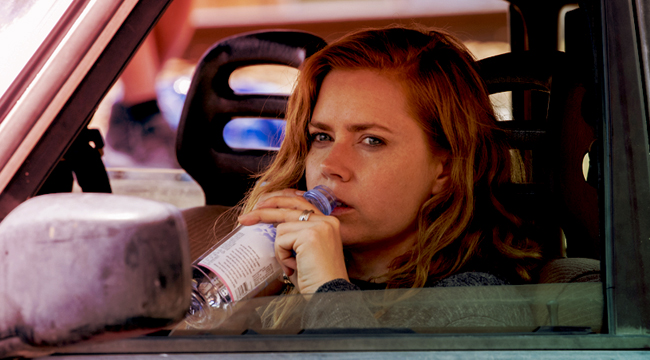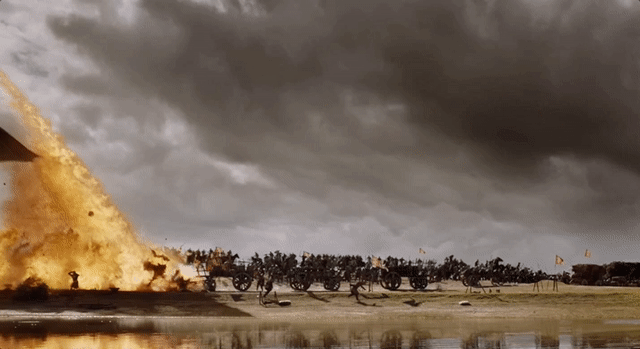
My biggest problem with Sharp Objects is that it is not a July show. It looks like a July show at first glance, sure. The new HBO drama is set in southern Missouri in the dead of summer. Everyone is sweaty (very sweaty) and sticky (very sticky). At times it feels like the on-screen humidity is so powerful and oppressive that it might start leaking out from behind the screen into my living room. It’s easy to be tricked into thinking we are dealing with summer content.
Please do not let the on-screen temperature fool you, though. The mercury lies. Summer shows are about a mood, a feeling, and the heavy subject matter and general tone make Sharp Objects better suited for a different time of year, one where it gets dark early and you don’t feel a pressing obligation to shave your face or legs and you are psychological prepared to dive into a bleak murder mystery. My first thought was that it was best suited to, say, late October or November, but that pushes the season finale up against Christmas. That won’t do either. Sharp Objects is a January show.
HBO has a habit of doing this, too. It’s a result of their Sundays-only scheduling practice (which might be on its way out). When you’re only running one or two big shows at a time, things can get slotted into goofy places. Sharp Objects had to wait until Westworld (an October show that debuted in April for some unknowable reason) was over before it could start. This means that, come August 12, when Succession (a March show that premiered in June) ends and Ballers (a May/June show) takes its place at 10 p.m., your next few Sunday nights will roll straight from a scar-covered Amy Adams solving child murders to The Rock and a dozen models doing shots on a yacht. It’s madness.
The most egregious example is The Leftovers. After a sensible October debut for the second season, the final season rolled out on April 16. April is a time of hope. The sun begins staying out through dinner and the plants and trees show their first signs of life after another desolate winter. The Leftovers might be the single least April show in television history. And it meant that the series finale aired on June 4. Imagine going to a pool party and then going home to watch the series finale of The Leftovers. I say this as someone who loves The Leftovers unequivocally and always will, but a belly full of flame-kissed meats and the smell of chlorine do not pair well with existential dread.
So then, if a show like Sharp Objects is not a summer show, what is? Claws. Claws is a summer show. GLOW, too. That’s just about a perfect show for an early-July binge, with all of its bright colors and triumphant obstacle-hurdling. Summer shows should typically be a little lighter and breezier than your fall and winter shows, or they should at least be a wild and fun version of a darker show. They should, under no circumstances, be hopeless dystopian dreadwatches. Looking right at you, Handmaid’s Tale.
There are exceptions to this rule, of course. Game of Thrones is a summer show, weirdly enough, even though it has dark themes and half of it takes place in a snow-covered wasteland and one of the bad guys is a literal ice monster named The Night King. This one I don’t have a great explanation for. I still feel it deep inside my bones, though, at a marrow level. I think it’s the dragons. Any show that features a dragon roasting hundreds of enemy soldiers from the skies feels like a summer show to me. This is all more of an art than a science.

Let’s bang out a few others quickly.
Mad Men — March
Breaking Bad — October
The West Wing — September
24 — February
The Wire — February
The Sopranos — March
Deadwood — October
Every USA show prior to Mr. Robot — May
Mr. Robot — November
Justified — September
House of Cards — Never
Stranger Things — June
The Handmaid’s Tale — January
Billions — July
Fargo — February
The Americans — November
BoJack Horseman — August
Atlanta — March
The Good Place — April
The Crown — October
Killing Eve — May
And so on. I can do this with almost any show, and I will if you ask me. Comedies are harder than dramas, admittedly. A full-length 22-episode network sitcom — The Simpsons, Parks and Recreation, Seinfeld — can work year-round. So can a straightforward procedural, like a Law & Order or an E.R. In fact, most shows that aired before the prestige boom of the late-90s worked this way. There weren’t a lot of hyper-targeted eight-episode seasons back then. Outside of a miniseries or a TV show, shows all ran on the same schedule, from September through May with a break for the holidays. They worked as year-round projects because they had to.
But now that things are debuting throughout the year (and please do use your 1997 brain to think about how strange it is that a big splashy series starring an award-winning film actress just premiered in July), shows can evoke more of a specific feeling. That’s why it’s important to time the premiere right. Because if you don’t, very normal and well-adjusted pop culture writers will spend a chunk of their summer failing to get into your dark murder show and then try to justify it with borderline delusional columns like this one.
Believe me, no one wants that.






